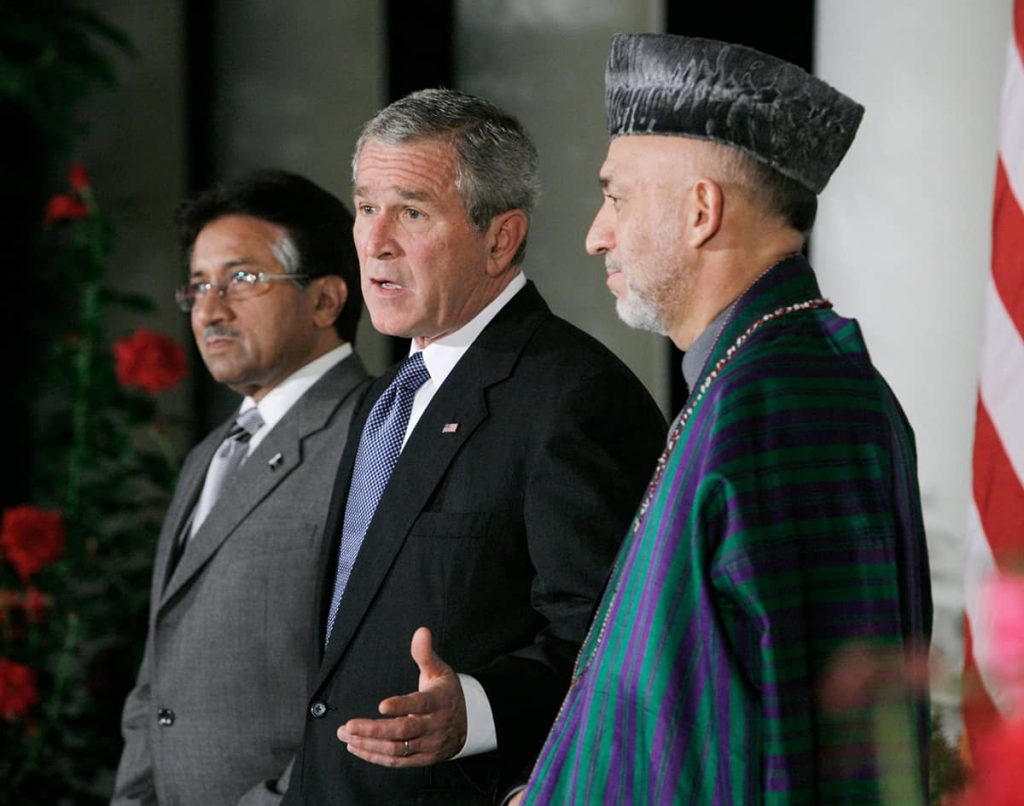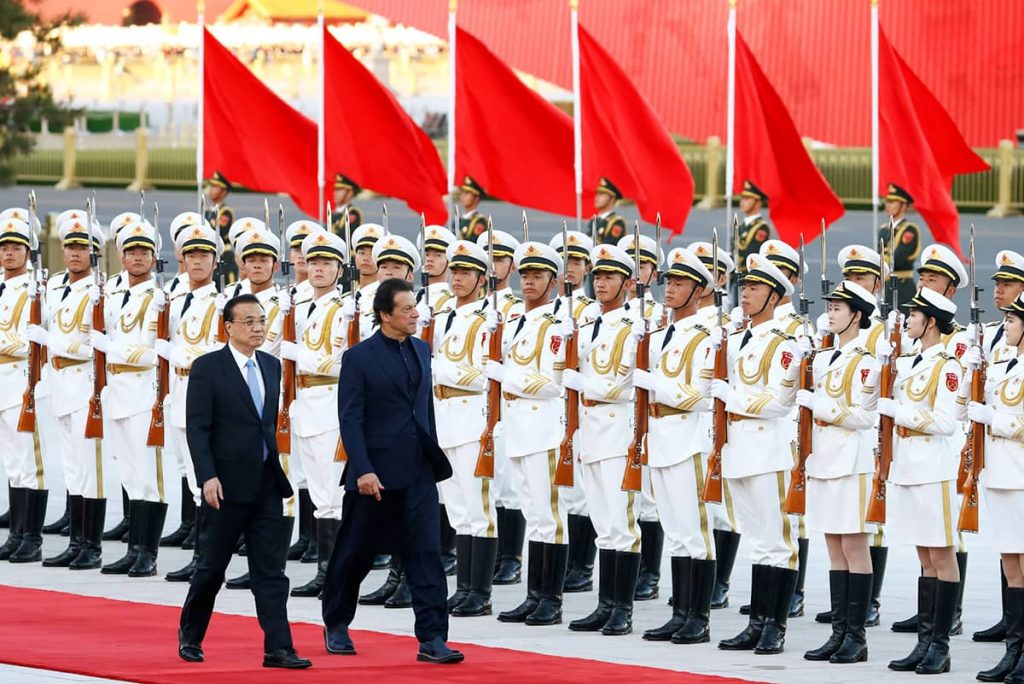The usual metaphor for the US–Pakistan relationship is that it is a roller coaster ride: dramatic ups and downs and rarely a stable ascending run. For much of the past two decades, the driver of this topsy-turvy relationship has been Afghanistan, toward which the two countries have pursued fundamentally differing strategic objectives, while publicly attempting to cooperate. The two questions are whether the end of the US military involvement in Afghanistan means that relations will become more “normal” and whether the US will succeed in pulling Pakistan out of China’s orbit. Frankly, it is hard to see either happening.
History
The course of the US relationship was set immediately after the events of September 11, 2001. President George W. Bush’s “you’re with us or against us” posture was directed at Pakistan more than any other country. In a series of high-level engagements between the US government and General Musharraf, Pakistan agreed to break with the Taliban government—Islamabad along with Riyadh and Abu Dhabi being the only powers that had recognized the Taliban government of the 1990s—and cooperate with the US war on terror. Initially, Pakistan provided access to US forces en route to Afghanistan, principally the Kandahar-bound Marines under then Brigadier General James Mattis. Islamabad also allowed US logistics routes through its territory, the so-called Ground Lines of Communication (GLOC) and Air Line of Communication (ALOC). The latter has proven essential even through the final withdrawal of US forces on August 31, 2021.
On the domestic front, Pakistan agreed to cooperate with the US in fighting al-Qaida within its territory—a position very much in Pakistan’s own interests. While much of this decades-long struggle took place in the dark shadows, some very visible results included the capture of Khalid Sheikh Mohammed, the mastermind of 9/11 and probable executioner of Daniel Pearl, and the steady degradation of the core capacities which had supported al-Qaida’s global reach.
In return for this cooperation with some of the US demands, Pakistan received a variety of emoluments: relief from the nuclear-proliferation related sanctions of the 1990s, including restoration of security assistance programs; participation in the Coalition Support Fund (a program of reimbursements for expenditures related to supporting the US war in Afghanistan); the granting of major non-NATO ally (MNNA) status; and under the Obama administration, $7.5 billion worth of civilian assistance under the “Kerry Lugar Berman” authorization.
But at some point—and fairly early on—Pakistan adopted a hedging strategy of publicly cooperating with the US while quietly countenancing and eventually supporting the reconstitution of the Taliban. This is a murky area in which decisions were made by extreme elements of the Pakistani deep state in a deniable, compartmentalized, and clandestine manner. Nonetheless, just as a theoretical physicist can detect the Higgs boson through its effects, a close observer of the Pakistani scene can see the impact of Pakistan’s Inter-Services intelligence (ISI) decision-making by its outcomes.
Islamabad, or more accurately Rawalpindi (where the Pakistani army is headquartered), apparently decided that the US was not fundamentally committed to stabilizing Afghanistan and that Pakistan needed to maintain ties with its traditional proxy, the Taliban. We can only speculate what prompted this decision, but it is easy to see that the early decisions by the Bush administration (a reluctance to do “nation building” resulting in inadequate civilian funding to back its military investment; the exclusion of the Taliban at the Bonn Conference; and the outright rejection of peace feelers from the Taliban) caused uneasiness in Pakistan while the decision to invade Iraq sealed Afghanistan’s fate. Always exquisitely attuned to the shifting moods in Washington, Pakistanis could see by 2003 that the US was not serious about Afghanistan and acted accordingly. It resumed backing the Taliban, who were now reconstituting.

Bush. Afghanistan’s Hamid Karzai and Pakistan’s Pervez Musharraf at the White House, in 2006. Photo credit: REUTERS/Jim Young
This contradictory policy of cooperation with the US and support for the Taliban continued through the Bush and Obama years, with American diplomats (the author among them) exhausting themselves by fruitlessly pressing the Pakistanis to effect a strategic shift and abandon the Taliban as they had done in 2001. This impasse was relieved only in 2018 when the Trump Administration definitively embraced negotiation with the Taliban as a means to end the “forever war.” Finally, Pakistan could deliver on a talking point that Americans had been deploying since at least 2011: expel the Taliban or bring them to the negotiating table. Pakistan brought them to the table.
Pakistan’s aims in pursuing an Afghan peace process (which Army Chief General Kayani had been promoting since at least 2009) were to generate an acceptable outcome in Afghanistan and create a degree of alignment with Washington. As we all know, the peace process failed, for reasons that go beyond the scope of this paper. But the end result in Kabul is very much a mixed blessing for Pakistan. Rawalpindi is comfortable enough with its proxy having decisively won the civil war; but recognizes— or should recognize soon enough—that having the war end in a humiliation for the US does not bode well for its future relationship with Washington.
The Dilemmas of Having Won in Afghanistan
Islamabad has been planning for—perhaps fantasizing about—its post-Afghanistan relationship with the US for some time. On the assumption that a political settlement would generate a stable western neighbor, and one that was at least not outright hostile to Pakistan’s interests, the relationship with the US could be “normalized.” According to Pakistan’s way of thinking, the relationship would focus on the purely bilateral aspects between the two countries, rather than on external relations, as it historically has been; during the Cold War, the US and Pakistan aligned against the Soviet threat and, since 2001—less successfully—on Afghanistan.
There are two problems with focusing purely on the bilateral relationship: First, from the American perspective, there is almost no content. While the United States is Pakistan’s largest export market, the volume of trade is of negligible importance to the American economy. American education and culture are important to the Pakistani elite, but it is hard to imagine a country with less soft power impact in America. The bilateral relationship is, in other words, too asymmetrical to be sustainable.
The second and bigger impediment is China. Islamabad’s relationship with Beijing is deep and long-standing. Arguably, Pakistan is a member of a very small club of countries (along with North Korea and Myanmar) that might be considered de facto allies of China—although Pakistanis are quick to point out that they have never concluded an alliance with the People’s Republic. The China–Pakistan Economic Corridor (CPEC), established in 2013, is the signature project of the Belt and Road Initiative and amounts to at least $60 billion worth of investment in Pakistan. It is widely seen within Pakistan as having significantly alleviated the country’s perpetual energy crisis, updated its infrastructure, and generally having provided a lifeline to the perennially floundering economy.
Under the Trump administration, the messaging on aligning with China was unambiguous. The State Department’s senior official on South Asia, Ambassador Alice Wells, delivered a devastating critique of the CPEC, which drew considerable attention and criticism in Pakistan. The Biden administration’s approach has been more nuanced, and has avoided presenting its partners in Asia with a binary choice of aligning with the US or with China, based on the realistic appreciation that most Asian countries do not want to make this choice. In the case of Pakistan, the dilemma hardly exists. China has largely supplanted the US as the primary foreign power providing military and development assistance. Pakistanis are clear that if a choice is to be made, they would feel compelled to choose China.
But despite Washington’s more nuanced approach, it seems inevitable that strategic choices will present themselves—particularly if, as seems to be the case, countering China becomes the new predominant framing concept for US foreign policy. If nothing else, how Pakistan chooses to proceed on developing a 5G network, may embed itself irretrievably in the China camp. Moreover, for the US, the active pursuit of Indo–Pacific strategy and its attendant elevation of its security relationship with India impose new costs to maintaining even a fairly modest relationship with Pakistan.

Pakistan’s answer to these dilemmas (and it faces similar ones with other traditional partners, such as the Gulf states) has been to announce a policy of shifting from geopolitics to geoeconomics. In March of this year, the government of Pakistan made two significant announcements at a semi-official think tank conclave in Islamabad: What got the most attention was Army Chief General Bajwa calling for a burying of the hatchet with India; less noted was the announcement that “geoeconomics” would be the central element of Pakistan’s national security policy. The Bajwa proclamation went nowhere, partly because of a lack of interest from New Delhi, but also because the Army Chief’s own politicians could not see a way to bring about the inevitable renunciation of claims on Kashmir without losing their political heads.
Geoeconomics, however, lives. Although it is not entirely clear what is meant by the policy, it seems to be an effort to attract foreign investment, boost exports, and enhance regional interconnectivity. While these goals are far from extraordinary in an Asian context, their explicit enunciation recognizes that Pakistan has largely missed the past few decades of globalization because it was mired in counterinsurgency and counterterrorism. From a narrower perspective, geoeconomics also seeks to present the CPEC as a regional common good (economic interconnectivity) and to present a friendly environment to boost foreign investment. Were this to occur, it would presumably mean that big investors like the US would actually have some content in, and stakeholders for, a strengthened bilateral relationship.
Unfortunately, geoeconomics is at best a work in progress. While Pakistan has made some improvements in its business climate—it climbed up the World Bank’s ease of doing business index—it still remains a challenging investment environment. Even though it has risen on the World Bank’s scale, Pakistan is still in the bottom half globally and the second lowest in South Asia. The Pakistani economy continues to suffer from serious structural challenges, including inadequate revenue generation, sporadic energy provision, corrupt and opaque governance, and many regulatory impediments to expanded investment. Even the CPEC, which, in theory offers special economic zones open to any and all investors, is sufficiently non-transparent that few non-Chinese firms seem to be interested. The best that can be said is that if the government remains solidly committed to reform, over time it can live up to the potential that Pakistan’s market fundamentals (a youthful and growing population, an expanding middle class, and a well educated elite) promise. But this would be a matter of decades, not years.
Afghanistan Redux
In the meantime, the challenges of Afghanistan remain. It does not appear that Washington has settled on a long-term strategy for Afghanistan. At the moment it is fully absorbed by three important but tactical considerations: How to conduct an over-the-horizon counterterrorism policy; how to evacuate our remaining citizens, partners and vulnerable populations; and how to prepare for an already looming humanitarian catastrophe as the Taliban attempts to manage an entirely aid-dependent economy with no expertise and perhaps no aid.
The Biden administration has identified its single vital national interest in the region as preventing a terrorist attack on the homeland emanating from Afghanistan. Despite the very public fulminations in Pakistan, the US has not asked Pakistan for basing rights and is unlikely to do so. What is more likely is that if a terror network again reemerges in Afghanistan, Washington will likely hold Pakistan accountable and expect Pakistan to solve the problem, at least in part because it was Pakistan’s hedging strategy in Afghanistan that wound up triumphing. And few in Washington are inclined to woo Pakistan, despite its nuclear weapons and demographic weight. The costs to Washington’s Indo–Pacific strategy would likely be too great.
As for Pakistan, it faces possible refugee flows from Afghanistan that could force a choice between accepting more Afghans—in addition to the millions it already hosts— or refusing their entry, which will generate international outrage. Moreover, the triumph of the Taliban in Afghanistan may generate more pressure from Islamists within Pakistan, and there are already signs of this. At the geo-strategic level, Islamabad has set its course of alignment with China but once again has hedged its bets by trying to fashion a new relationship with the US. But this time around, the hedging strategy is unlikely to triumph.

